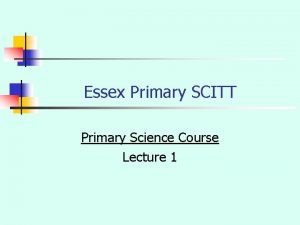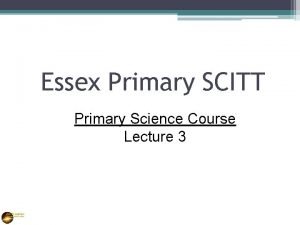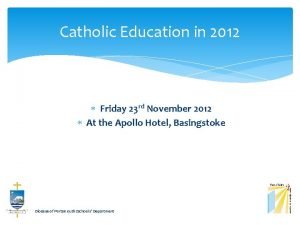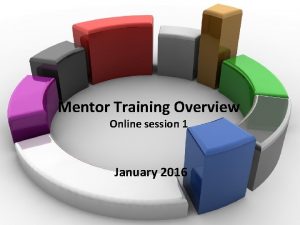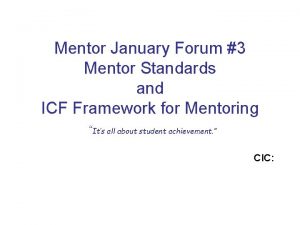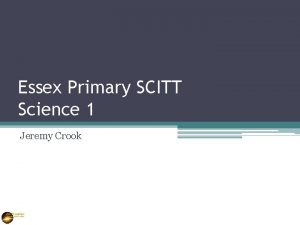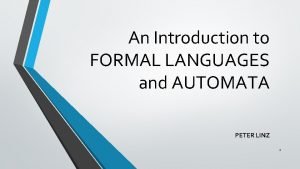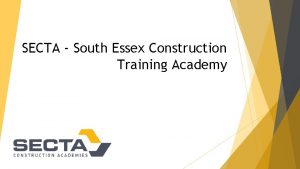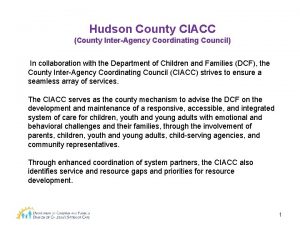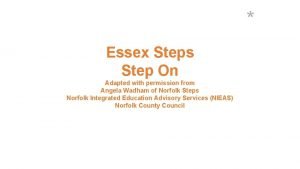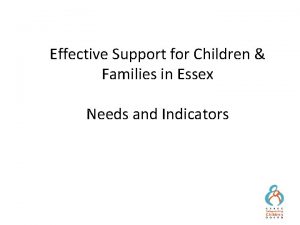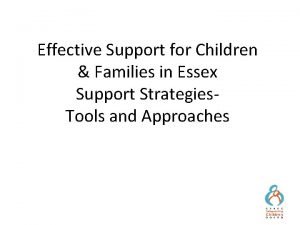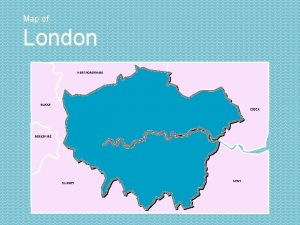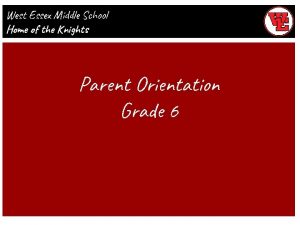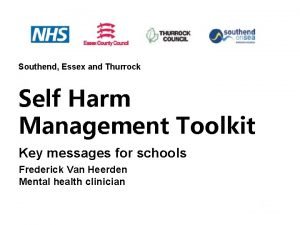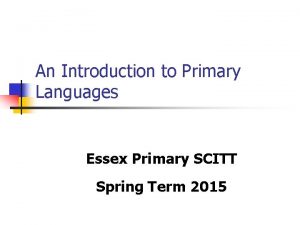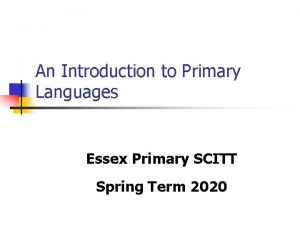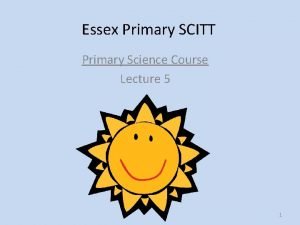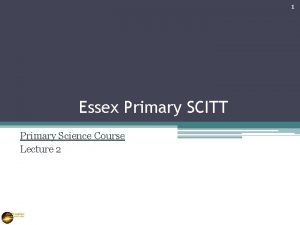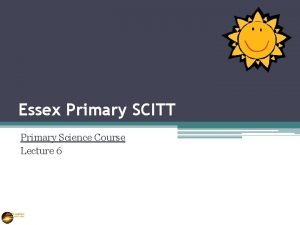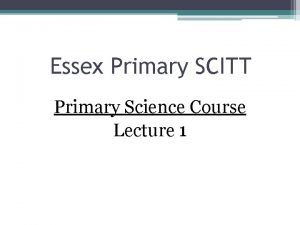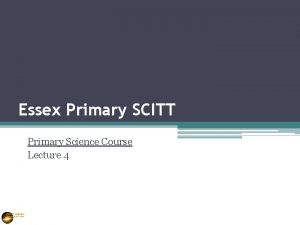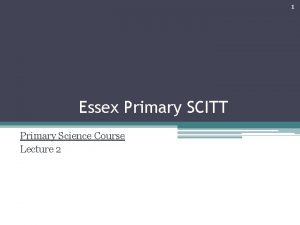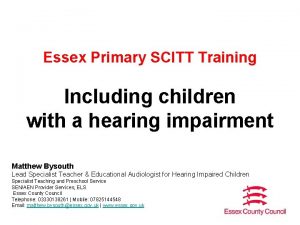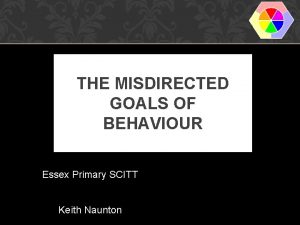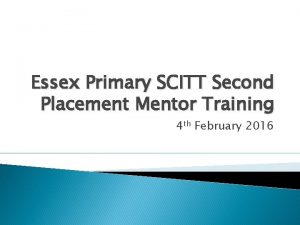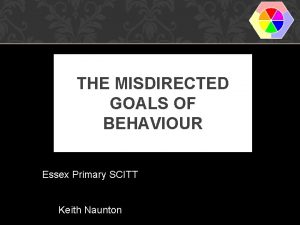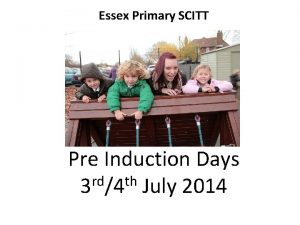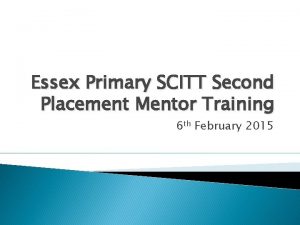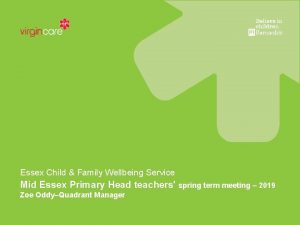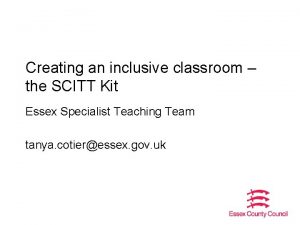An Introduction to Primary Languages Essex Primary SCITT





























- Slides: 29

An Introduction to Primary Languages Essex Primary SCITT Spring Term 2019

Objectives n n To become familiar with National Curriculum expectations for language learning To understand the key principles of early language learning. To explore ways to introduce languages in the primary classroom. To consider effective planning for progression in language lessons

Implications for teaching languages n n n You don’t have to be fluent in a language to teach it effectively! Resources are available to support primary practitioners Keep content limited so that you teach topic areas you are familiar with

Overview of the national context and expectations

Language teaching n n n The teaching of a foreign language to children from Years 3 to 6 is compulsory National Curriculum 2014 indicates subject content This covers general skills and knowledge – not particular topic areas or languages.

Teaching time n n n The recommended time allocation for language teaching is a total of one hour per week. Research has shown that the most effective model is to split this hour into one dedicated lesson of approximately 30 minutes, and some supplementary sessions of 5 -10 minutes delivered throughout the school week. Other models of organisation are possible but language teaching is more effective when appropriately embedded.

The National Curriculum for Languages Purpose of Study A high-quality languages education should foster pupils’ curiosity and deepen their understanding of the world. The teaching should enable pupils to express their ideas and thoughts in another language and to understand respond to its speakers, both in speech and in writing. It should also provide opportunities for them to communicate for practical purposes, learn new ways of thinking and read great literature in the original language. Language teaching should provide the foundation for learning further languages, equipping pupils to study and work in other countries.

The National Curriculum for Languages Programmes of Study/Subject content Teaching should focus on enabling pupils to make substantial progress in one language Skills covered: n n n Listening Speaking Reading Writing Understanding Grammar

The principles of Early Language Learning

Principles of language learning n Key stages: n n n Repetition Recognition Recall Real context Go through the cycle for each new topic. Move between stages, returning to each stage frequently.

Repetition n n Using a range of stimulus. E. g. flashcards. Using another “first voice”. E. g. CD/ICT. Making repetition varied. Need for regular practice. Time to consolidate.

Recognition n Children need opportunity to demonstrate understanding through recognition. Use flashcards and physical responses. Reinforcement through games.

Recall n n Children get the opportunity to produce the language. Move to this stage only when children are ready.

Real context n n Children get the opportunity to use learnt language in a new context. E. g role play. Children’s learning needs to be extended beyond individual words.

Context to practise the 4 Rs n Topic area: colours n Key structure: do you like? I like … n Outcome: survey to find out the class’ favourite colour.

Sample activities based on the 4 Rs n Word level activities: n Repetition: Using a range of voices/ speeds n Hot and cold game n Pass the colour n Recognition: n Repeat only if true n Which number? n Sentence level activities: n n n Recall: n Either/or n Connect 4 n n n Repetition: n Chanting a sentence n Pass the sentence around your table. Recognition: n Responding to a sentence Recall: n Guess my favourite colour Real context: n What is the group’s favourite colour?

Introducing Literacy n n Reading and writing skills need to be taught in all year groups Literacy activities will run alongside oracy activities The 4 Rs approach applies to literacy activities as well as oracy What are the possible pitfalls when working with the written word?

Examples of literacy activities - Reading n n n Matching written word to picture Responding to the written word Reading games n n n Memory games Circle games Word sorting Dominoes Pictionary Reading for a purpose

Examples of literacy activities Writing n Copy writing n Word games n n Hangman Missing letters Guessing games Writing for a purpose

Ways to reinforce language learning through the week n n n Using the register Early morning work Classroom instructions P. E. lessons Other curricular areas Short games and activities

Classroom instructions n n n Giving some instructions in the target language is a good way of increasing children’s exposure to the language Start with one or two instructions and build up Try having an ‘Instruction of the Week’

Planning for progression

What makes an effective scheme of work for languages? n n Driven by demands of NC and the needs of the learners rather than by a resource Organised into units of work, allowing sufficient time to explore topics in appropriate depth Each unit includes work at sentence level and has a clear, defined outcome Clear progression from one unit to the next and from one year group to the next

Progression through the scheme n n n There should be clear progression across the scheme Progression comes from development of language skills Increasing complexity of sentence structures also extends children’s language learning

Key structures Do you have…. . ? I have / I don’t have … What is it? It is … Do you like…. ? I like / I don’t like … What is there? There is … What is it like? It is …(description) What would you like? I would like … Where is it? It is. . . (using prepositions)

Key principles of a unit of work n n It is built around objectives (linked to the 2014 Curriculum Programmes of study) It shows progression from word to sentence level There is a balance between new and previously learnt language Pupils are working towards a key end of unit outcome

Possible structure of a unit of work n n n Introduce new vocabulary (individual words or phrases) Introduce sentence structure Introduce written forms Consolidate learning, linking sentence to nouns learnt Teach/revise any other language needed to prepare for outcome Complete outcome

Exploring a unit of work Unit of Work for Y 3 – The Enormous Turnip

Plenary n n n How does this approach compare to the way you have learnt another language? How confident do you feel to teach a language at Primary level? What are the implications for your own professional development?
 Essex primary scitt
Essex primary scitt Essex primary scitt
Essex primary scitt Essex primary scitt
Essex primary scitt West essex primary care trust
West essex primary care trust Pcp scitt
Pcp scitt Scitt moir
Scitt moir Scitt moir
Scitt moir Science enquiry types
Science enquiry types Ctsn scitt
Ctsn scitt Ctsn scitt
Ctsn scitt Introduction to scripting languages
Introduction to scripting languages Introduction to programming languages
Introduction to programming languages Gtg stands for in automata
Gtg stands for in automata Secta training academy
Secta training academy Iosh training essex
Iosh training essex Shifts in poetry examples
Shifts in poetry examples Oates essex
Oates essex Ciacc essex county
Ciacc essex county Essex steps
Essex steps Effective support for families in essex
Effective support for families in essex Essex wessex mercia northumbria
Essex wessex mercia northumbria American hero by essex hemphill
American hero by essex hemphill Families in focus essex
Families in focus essex Effective support for children and families in essex
Effective support for children and families in essex Hepscd
Hepscd Essex to berkshire
Essex to berkshire Joint meeting of essex and union counties
Joint meeting of essex and union counties Damion macioci
Damion macioci Self harm toolkit essex
Self harm toolkit essex 7 minute safeguarding briefings essex
7 minute safeguarding briefings essex
